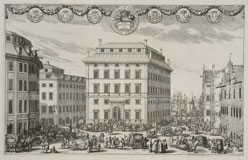 In 1668 the Riksdag (the Swedish parliament), which consists of the nobles, the clergy and the burghers, decided to re-establish Stockholms Banco under the name the Bank of the Estates of the Realm.
In 1668 the Riksdag (the Swedish parliament), which consists of the nobles, the clergy and the burghers, decided to re-establish Stockholms Banco under the name the Bank of the Estates of the Realm.
During the Caroline years Kings Karl XI and Karl XII exercised considerable influence over the Bank. It was forced, for instance, to finance the Great Northern War. The financial strains this entailed meant that no money could be paid out.
Time axis
| 1668 |
The Riksdag approves the Bank of the Esates of the Realm - the venture is backed by the Nobility, the Clergy and the Burghers; the Peasants decline.
|
| 1672 |
Karls XI comes of age.
|
| 1675-9 |
War against Denmark, financed by the Bank.
|
| 1680 |
Karl XI's reversion of alienated estates. The Bank move into premises at Järntorget in Stockholm's Old Town.
|
| 1689 |
Royal autocracy asserts its power over the Bank.
|
| 1680s-90s |
The Bank of His Majesty's Estates. Chas receipts and approved assignments are introduced.
|
| 1697 |
Karl XI dies and is succeeded by Karl XII.
|
| 1700 |
Great Northern War, financed by the Bank.
|
| 1701 |
The Bank introduces transfer notes, forerunner of modern banknotes.
|
| 1709 |
Sweden loses the battle of Poltava.
|
| 1711 |
Johan Thegner joins the board of directors as the Nobility's representative, chairs the board and leads the Bank for three decades.
|
| 1718 |
Karl XII is killed at the siege of Fredrikshalds in Norway; succeeded by Ulrika Eleonora. |
Did you find this information helpful?
Yes
No
Thank you for your help!